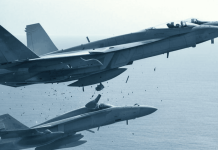Realizing that 5G (fifth generation of technology) of mobile technologies is now a critical weapon and it is way behind China in utilizing this weapon effectively, the United States is pulling ahead the Department of Defense (DOD) to play a critical role in the wireless arms race by not only bridging the gap with China but also leading over it.
Through the December 2023 National Defense Authorization Act (NDAA), the U.S. Congress has devised a policy that mandates that all DoD bases and facilities deploy a 5G O-RAN private wireless network customized to the specific bases’ needs.
It may be noted that in 2020, Congress allocated $650 million to seed 12 (twelve) 5G pilot projects at U.S. military bases in order to spur innovation and ignite American 5G supply capabilities.
In what was more or less a bipartisan move, the latest legislation, passed last month by both the Senate and House of Representatives, said: “The Secretary of Defense shall develop and implement a strategy for deploying private networks, based on fifth-generation information and communications capabilities (5G) and Open Radio Access Network (ORAN) architecture, to military bases and facilities that are tailored to the specific mission, security, and performance requirements of those bases and facilities.”
The Congress also recommended that the American military bases must create a “common, transparent and streamlined process” for commercial mobile network operators to install their 5G networks at those locations”. The base commanders were asked to consider public/private neutral host networks using Multi-Operator Core Network (MOCN) architectures.
The new NDAA legislation strongly backed the Pentagon’s Joint All-Domain Command and Control (JADC2) effort or vision for connecting “sensors with shooters across all domains, commands, and services.” JADC2 is a comprehensive, interoperable wireless networking system that would basically connect everything owned and operated by the Pentagon.
With the above view in mind, Congress has allocated $179 million for DOD research into “Next Generation Information Communications Technology (5G).”
Incidentally, 5G technology has made a reality of what military leaders as far back as the 1980s referred to as the “infosphere,” where access to data from video, voice, sensors, targeting, reconnaissance, and even the sights on infantry weapons are accessible easily and instantaneously for all who needs it.
Because of its ubiquitous high-speed data connectivity, 5G has vastly improved intelligence, surveillance, and reconnaissance (ISR). It could enable what is said to be “fast and secure command and control,” “more efficient logistics,” “swarming unmanned vehicles,” and “wide use of virtual reality and augmented reality for simulation, training, and mission rehearsal.”
The promise of 5G is for “instant situational awareness anywhere on Earth, smart hypersonic weapons with re-targeting on-the-fly, rich access to mission-critical data on the leading edge of the battlefield, and unmanned aircraft that can fly safely alongside passenger aircraft in commercial airspace“.
According to a Cyber-expert who once was a Special Agent with the FBI, where he conducted numerous cyber counterintelligence computer-intrusion investigations, 5G is extremely beneficial for the following military applications:
-
It connects more devices and end users, which is essential when quickly building up massive networks with thousands of devices communicating across a single infrastructure. 5G accounts for the diverse types of end devices beyond just smartphones, including robotic devices such as uncrewed aerial systems (UASs), video surveillance, or sensors monitoring everything from weather data to warfighters’ vital signs.
-
High-speed, high-bandwidth interconnect at extremely low error rates is important for data-intensive applications such as video surveillance at high resolution or for augmented-reality/virtual-reality (AR/VR) imagery.
-
Low-latency communication is essential for applications that require fast response times and timely delivery of time-sensitive data. Examples include machine control data of robotic devices, including UASs and those used for swarm intelligence, creating decentralized, self-organized systems. Multi-access edge computing (MEC) also benefits from 5G by aggregating and processing mission-critical data on the battlefield, reducing the need for slow and unreliable long-distance connections.
-
It operates across a broad spectrum from less than 1 GHz up to 5 GHz, which allows it to adjust to its application with a single communication network. Lower frequencies enable larger networks that reach further but are more easily detectable. Higher frequencies, however, create shorter reach for fewer devices (i.e., microcells) and are therefore less likely to be detected.
-
Highly secure architecture: 1) All user and control traffic has highly sophisticated encryption methodology such as TLS 1.3, which more securely encrypts both data transport and the initial authentication; and 2) 5G is designed to use software-defined networking to create a highly segmented network to limit lateral movement, separating user and controlling traffic more effectively.
-
Efficient energy consumption: 5G enables more efficient energy consumption, which is essential for small devices such as microdrones, UASs, or wearable sensors.
-
A worldwide standard enables sharing and communicating across battlefield infrastructures more easily for the varying national military services and allied partners.
Here, it is worth mentioning that 5G technologies use three segments of the electromagnetic spectrum (“the spectrum” ): high band (also called millimeter wave, or MMW), which operates between around 24 and 300 GHz; mid-band, which operates between 1 GHz and 6 GHz; and low band, which operates below 1 GHz. Mid-band and low band are often collectively referred to as “Sub-6″.
Though MMWs allow faster data transfer rates, they travel comparatively short distances and can be absorbed by rain or disrupted by physical objects such as buildings and vehicles.
As a result, 5G MMW technologies require installing a higher number of cell sites—at a much higher cost and on a much slower deployment timeline than the sub-6 approach that, though a little slower, can facilitate nationwide coverage.
Apparently, China is the current leader in sub-6 technologies and is likely to deploy the world’s first 5G wide-area network. Chinese companies, which often receive government subsidies (e.g., subsidized land for facilities, R&D grants), are said to be well-positioned as global 5G suppliers. Huawei, for instance, has signed contracts for the construction of 5G infrastructure in around 30 countries.

U.S. military planners are worried that vulnerabilities in Chinese equipment could be used to conduct cyberattacks or military/industrial espionage. It is said that vulnerabilities could be intentionally introduced for malicious purposes, given the fact that China’s National Intelligence Law, enacted in June 2017, declares that every Chinese organization and citizen “shall cooperate with intelligence services, including compelling installation of backdoors to provide private data to the government.”
This explains why the American Defense Innovation Board (DIB) has advised the DOD to consider sharing the sub-6 spectrum to facilitate the build-out of 5G networks and the development of 5G technologies used in the sub-6 band.
It may be noted here that DOD holds large portions of the usable spectrum. While it has been moving toward greater spectrum sharing, it has expressed concern that sharing presents operational, interference, and security issues for DOD users.
As an alternative to spectrum sharing, some analysts have argued that portions of the sub-6 spectrum should be reserved for commercial use. This would require DOD to relocate certain applications to other parts of the spectrum. DOD has argued that moving out of the 3.1-3.45 GHz band alone could cost at least $120 billion and take decades.
In response to these security concerns, Congress has devised a number of Acts and measures. It has passed the Secure 5G and Beyond Act, requiring the President to develop a 5G protection strategy. Section 254 of the FY2020 National Defense Authorization Act (NDAA) requires the Secretary of Defense to develop a DOD 5G strategy.
These strategies were released in two installments in March and May 2020. DOD released an associated 5G implementation plan in December 2020. In addition, Section 224 of the FY2021 NDAA directed DOD to create a 5G governance structure, while Section 225 directed DOD to demonstrate the maturity of 5G component technologies.
Section 233 of the FY2022 NDAA directed the service secretaries to develop a plan for 5G pilot programs on military installations, and Section 221 of the FY2023 NDAA directed the Secretary of Defense to identify a target date for 5G deployment at all installations. Section 234 of the FY2023 NDAA additionally tasked specified Assistant Secretaries with developing three-year transition plans for 5G.
Accordingly, DOD selected 12 military installations as test beds for 5G applications: Marine Corps Logistics Base Albany, GA, and Naval Base San Diego, CA (“smart warehouses”); Hill Air Force Base, UT (“spectrum sharing between 5G and airborne radar”); Joint Base Lewis-McChord, WA (“augmented and virtual reality”); Nellis Air Force Base, NV (“survivable command and control and network enhancement”); Naval Base Norfolk, VA (“ship-wide and pier connectivity”); Joint Base Pearl Harbor-Hickam, HI (“enhancing aircraft mission readiness”); Joint Base San Antonio, TX (“augmented reality support of maintenance and training” and “evaluating DOD’s 5G core security experimentation network”); Tinker Air Force Base, OK (“spectrum sharing between military communications and 5G”); and Camp Pendleton, CA; Fort Hood, TX; and Fort Irwin National Training Center, CA (“connectivity for forward operating bases and tactical operations centers”).
Joe DiGuardo, a retired U.S. Navy rear admiral, has pointed out that from the above test beds, two success stories have stood out: the Marine Corps Logistics Base at Albany, Georgia, and Naval Air Station Whidbey Island in Washington State.

“At Albany, a pencil-and-clipboard process has been replaced by self-guided material movers and an automated inventory system running on 5G, increasing efficiency and inventory accuracy and freeing up military personnel for more critical tasks. At Whidbey, automated jet engine inspections and a new refueling process run on 5G, dramatically cutting down aircraft turnaround time.
“Both Albany and Whidbey use dedicated, ‘private’ 5G networks — meaning the DoD owns and operates them independent of commercial cellular networks — built with American technology. This tech provides two key elements required by the DoD to ensure a secure and viable 5G supply chain: Open Radio Access Network, or O-RAN, architecture, and a software-based solution. O-RAN allows for components from multiple vendors to operate together as one network, so the DoD is not locked to one supplier – critical for our national and economic security. The software solution provides the flexibility to scale from a command post to an entire base, which is also not possible with traditional cellular hardware“, DiGuardo reveals.
The fact that the latest National Defense Authorization Act (NDAA) in December 2023 has now talked of the mandatory use of the O-RAN technology seems to have encouraged experts like DiGuardo to suggest that “The U.S. military must develop the (more) requirements at each base so that Congress can fully fund this initiative and accelerate its rollout.” Because, for him, winning the 5G arms race requires full funding from Congress.
After all, Secretary of Defense Lloyd Austin has testified before Congress that “the Department is committed to making the United States a world leader in 5G by working with the commercial sector and fielding 5G to the warfighter.”
- Author and veteran journalist Prakash Nanda is Chairman of the Editorial Board – EurAsian Times and has commented on politics, foreign policy, and strategic affairs for nearly three decades. A former National Fellow of the Indian Council for Historical Research and recipient of the Seoul Peace Prize Scholarship, he is also a Distinguished Fellow at the Institute of Peace and Conflict Studies.
- CONTACT: prakash.nanda (at) hotmail.com
- Follow EurAsian Times on Google News




